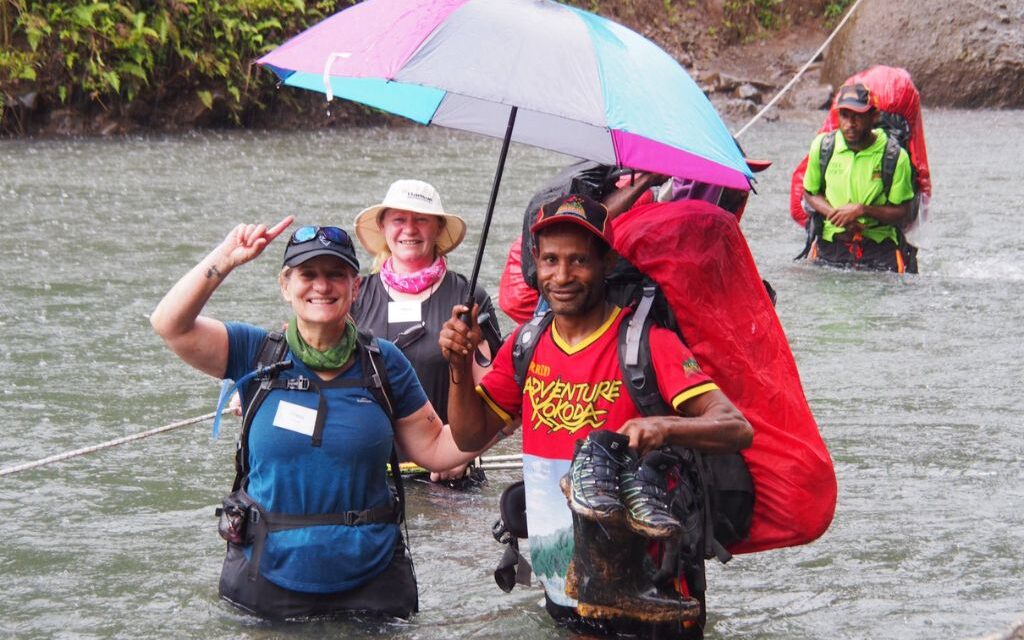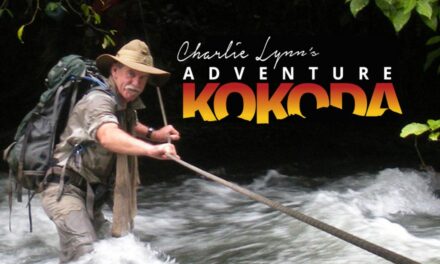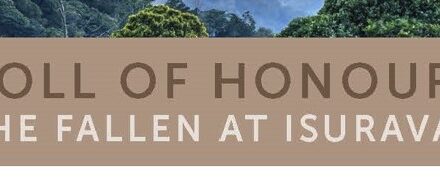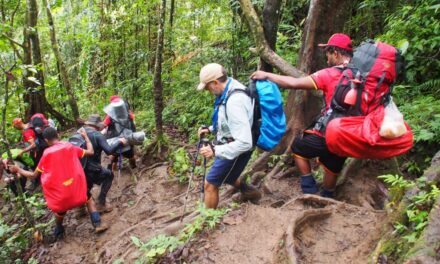Kokoda 10 Top Tips for Women to help you prepare for trekking the Kokoda Trail.
Follow Karyn Hayden’s incredible Kokoda journey . . .
It started with our usual Saturday morning sojourn to Chelsea. This time however, as we walked past an empty shop, we noticed that Personal Gym Trainers were moving in. Sparking our interest, we read their information on the window. Among their list of achievements and goals was the statement “Training for the Kokoda Trail”. After reading this, Martin turned to me and said “you could do that”, and my reply was “I would love to”! “Well then”, he said, “you better make enquiries”. My incredulous “are you serious” was greeted by “of course”.
“And so, my 15-week journey began. “Kokoda”, Googled on the internet brings up a myriad of sites and links, but it didn’t take me long to locate “Adventure Kokoda”, and to decide that they were the people that I would travel with. My first reason was because of the Historical content of the trek, – we would be following “In the footsteps of the brave”, retracing the battle of retreat, and the various battle stands and abandoned armaments etc. Secondly, the strong emphasis on safety (which was paramount to Martin), was not biased just on what Adventure Kokoda offered, but made you well aware that whoever you trekked with – there was certain criteria and procedures that were essential. And lastly (this appealed to me most), was the financial and practical support that Adventure Kokoda gave to the different villages that we would be passing though.
“My trek was for ten days, so why refer to it as my 15-week adventure? One week was devoted to investigation and booking, and 12 weeks for intensive training (I don’t think there was a day in the first 6 weeks that I wasn’t sore somewhere!). In amongst all of this was the compiling of “my kit”.
“I had worked out with weights for years, but apart from hockey at school, the odd time on the treadmill, and a short introduction to rowing, cardio exercise was not something that appealed to me. All that was to change. After consulting with “Rick”, a personal trainer at my gym, I embarked on a program which escalated every week, concentrating mainly on leg strength and recovery, until I was walking the Moorooduc Quarry 6 laps at a time, Olivers Hill 8 laps, and many walks, which included two all day 30km walks, all with me carrying an 18kg pack!
“They say that nothing prepares you for Kokoda, except Kokoda, and that is exactly right, but my training held me in good stead – I knew I would probably find the cardio side difficult – I didn’t want to be the fastest or the fittest, I just wanted to be able to “keep on going”, and be able to enjoy the trek. I exceeded my expectations, although at times I did have doubts, and when this happened, I would hear Rick’s voice urging me on for “400 metres more”, or “you’re nearly there – trust your strength!”.
“13 weeks sounded plenty of time to get ready, then suddenly I was flying out the next day!
“Arriving in Port Moresby was hot and humid, and the progression through customs, and changing my money to Kina, was slow. I was starting to feel quite overwhelmed. When I finally got through, it was just as Adventure Kokoda had advised on the itinerary – look for your head guide in a red T shirt and hat – and there he was, which was an instant relief to me, and with him was our (Australian) trek chiefs, Chad, and his 2IC Ron.
“Right from the beginning, the organization of the trek was professional and efficient. Chad had already picked up our room keys from the Hotel, and once we had them in hand, and we were all accounted for, there was no waiting around or hold ups. A “very fast” mini bus ride to the Hotel, and I arrived at a very colonial setting – large white buildings and lovely plush gardens, within a compound complete with iron gates and guards! We would soon find out that anything worth keeping needed barricading in. However, although it all felt quite foreign, we were safe and comfortable. After picking up our packs, packing them with our gear, and then getting them weighed (if you were carrying more than 12kg dry weight – add 3kg for water, – you were carrying too much) we had a briefing on what to expect on the track, and the protocol with the villages.
“Over dinner we had time to get to know each other a bit better (I don’t think I remembered everyone’s name until the last day!).
“After dinner was another briefing on the political situation of 1942, the strategic battle sites we would be moving though, and about the soldiers we would get to know.
“Next morning, we enjoyed our last hot showers for 10 days, had a lovely buffet breakfast, and proceeded to check out of the hotel. A short (and fast) bus ride to the private airfield and we settled in for the wait until we would be flown (in two batches) to Kokoda. We had to get used to PNG time, I believe a bit like Bali time. The plane flies up the Kokoda Gap, which is flanked by the Owen Stanley Range on one side (our trek), and Mt Victoria and Range on the other – 20 minutes to get there and considerably longer to get back! Our pilot flew quite low in places so we could get a good look at villages, memorials etc, and it felt like you could reach out and touch the mountains!
“At last, Kokoda! The Airport is a grassed strip and a couple of buildings that look like exotic bus shelters. We had quite a wait for our 2nd batch of trekkers to arrive (another introduction to PNG time) so when we were finally together, we were all keen to just start walking!
“At this point we were matched up with our personal carriers. By default (I was standing next to Chad) I was first, and my man was Laune. Laune, I found out later, was 21 and very slightly built – he looked more like a marathon athlete – but I was to find out he was very savvy, strong, and regal. I could imagine him as a displaced warrior prince, waiting to redeem his throne!
“Finally, it was time to “saddle up” (we learnt various catch cries along the way) and we were on our way to our first battle station. Four of the seasoned trekkers carried their own packs, but for the rest of us, it was just a smaller day pack with the essentials. One of the main reasons for the weight restrictions on the big packs was because your carrier also had to carry his own gear! Also, you learn that not only do the “boys” carry your pack, they take the tougher route, so you have the easier one (if there is such a thing!), and also help you over the tough bits. As we were to find out, the track alternated between a goat track, or just foot holds, up or down the mountain, or a maze of tree roots up to a foot high. Add in loose gravel, or mud when it’s raining, and it’s easy to feel totally inept in their shadow. Please know that the term “boys” is not made in a derogatory manor – they call themselves “the boys” – it’s more of an acknowledgement.
“Our 1st night under canvas eased us into the routine we would continue for 10 days. Except our 1st walk was only 2½ hours, with the weather fine and clear, if not a little hot. We arrived at camp to find some of the boys (the group carriers) had run ahead of us (yes, run!), so that when we arrived our tents were erected, the fires were lit and dinner was well under way.
“This night we camped by a flowing creek which was freezing, but great to ease our sweaty tired bodies into (if only we knew what was to come!).
“Dinner alternated between Deb potatoes/pasta/rice and stew of sausage/tuna/meat, with the usual spreads, biscuits and condiments, accompanied by tea/coffee/Milo, and most of the time, fresh fruit and vegies from the village we were staying in, or from nearby.
“Off to bed by 7.30pm in our 2-man tent – which was just enough space for you, and your packs. Once I was organised, I thought it was fun, like my own cubby hole, but when I said this to Steve, a fellow trekker, he said “Yeh, but look at you, and look at us!” – meaning the size difference, and that he didn’t see it as quite the same adventure.
“Up at 5.30am to dress (with a head torch), re-pack, and have the tent empty so Laune could dismantle it for the group carriers. A breakfast choice of hot food, being baked beans (we all designated those people at the back of the line – especially uphill!), spaghetti, muesli and weetbix with hot powdered milk, canned fruit, and again, the usual condiments etc.
“We would “saddle up” and be on our way by 7.30, stop for morning tea around 10/10.30am that appeared miraculously out of the bush, and lunch around 1/1.30pm, usually at a village, but sometimes just at a campsite – pasta, canned meat and tuna, Kraft processed cheese, beans and the usual condiments etc. Afternoon tea was around 2.30/3pm and camp would be reached around 5pm (you knew it was time to stop when you smelt the fire – unless it was someone else’s, which was very disappointing). Include in this our stops for battle site briefings, and stops just to catch our breath and each other, and you wonder how much walking we did a day, but in the end, it added up to 130kms!
“The Kokoda track is 96kms, being the most direct route between Owers Corner and Kokoda. Adventure Kokoda doesn’t follow the Kokoda Trail, as much as the battle sites of the war over the trail. AK (Adventure Kokoda abbreviated – we were known as AK826 – the 26th trek in 08) takes us to sites and villages off the track. A couple of villages we stay at are not visited by other trekkers, hence the 130kms.
“I mentioned that I was attracted to AK because of what they put back into the track. Money “raised” by people trekking is re-invested into villages via their schools and hospitals. AK also sponsors students in both villages, and Port Moresby. In addition, actually trekking through these villages allows us to supplement the village income by purchasing produce and mementos as we go through, but also, because AK passes through regularly, our leaders can pick up when medical assistance is required and can either treat, or instigate medical assistance where required – which did happen along the way. On top of that, to see the rapport that Chad and Ron had with the people from the villages, and the mutual respect they had for each other was rewarding in itself. And of course, another way they support the villages is to employ “the boys” to assist in the treks. Of course, AK isn’t the only employer, but they not only make fair payment, but supply uniforms, sleeping gear and food, which unfortunately is not always the case.
“Once you get to know the boys, you find that most of them are related – fathers/sons/brothers/cousins, and when we met trekkers passing the other way, it was a pleasure to see the boys greet each other.
“We were a group of 29 trekkers, 25 personal carriers, and 50 group carriers. Our trek leader Chad and 2IC Ron were ex Vietnam vets. Chad had been awarded the Military Medal. So, we were in good hands! We also had our head guide, Noxy, who always lead the way with a shovel, to clear the track as we walked – when he walked, we walked, with the catch cry “Rock and Roll up”, or “Rock and Roll down” whichever we were doing at the time, and when he stopped, we stopped – there was no passing or trying to race him. Our Medico was Markson. So, we were a large group, but it never felt large, or cumbersome – we were like a village – settling down for the night, and moving off in the morning.
“One aspect I should mention again at this stage is the military emphasis placed on the trek by Adventure Kokoda, the principals of which are all ex-military, one as I said, being awarded the Military Medal. They believe that not enough importance has been given to the Kokoda Campaign, which really did play a large part in “saving” Australia. We were informed that “At Gallipoli, the Australians fought for England and lost, but at Kokoda, they fought for Australia, and won”.
“So, there was a lot of emphasis on the military, and we actually followed the “Battle Track”. Consequently, we visited all of the important Battle Sites, saw numerous old gun emplacements etc, and lots of unexploded ammunition carefully “arranged” for our viewing by the local villagers. Of course, there were many, many memorable sites along the track, and these were all explained to us, moving many of us to tears.
“It is interesting to note how close the Japanese came to victory. When they reached Imita Ridge, from where they (the Japanese) could see the lights of Port Moresby, they were given the order (from Tokyo), to “Advance to the Rear” – there being no word for “Retreat” in the Japanese Military vocabulary. It was that close!
“Travelling like a village meant that when we set up, there was nothing there, and when we left, there was nothing left. We passed a number of other trekkers who, after lunch/camp, left, and left their rubbish – there’s no rubbish collection on the Kokoda! It’s sad enough to see the villages unable to cope with the refuse of ‘progression’, let alone see it wilfully left. The other eye sore was the graffiti and vandalism. Yes, even in the jungle! Trees with root systems that started from 20 feet up the trunk were etched with initials of passer-bys. There are precious little memorials to our diggers on the track, and to see the ones that are there have been chipped to take mementos is, well – you wonder where peoples’ minds are.
“Despite these disappointing memories, I will have heaps to cherish. We would arrive at a village to have the locals lining the path and greet us with shy hellos and smiles. Choirs would sing to us at our camp sites and then we would find out that they walked 7kms to reach us, and then walked home the next day! A couple of times Laune, my personal carrier, became head guide which meant that we ‘lead the pack’. Laune would look for me to make sure I was behind him, and while leading and securing the track, he would be looking after me as well – after I fell and gashed my wrist, I technically became one handed. When I managed to walk in sync with him, it felt like we were flying over the ground. At one stage we were walking down a steep muddy slope and he was behind me with one hand on my pack to steady me, and a machete in the other! Another time, again in the mud, he was behind me, slipped, took me out with him, and we both sat in the mud and laughed.
“One lesson I will remember, is what I learnt though Chad. Our group of 30 trekkers, which sounds large, has a couple of reasons why. Firstly, a larger group has a stronger safety aspect – we are in a developing country – and whilst it would be nice to think that because we are on holiday, we are safe, that’s not always the case.
“But what will remain with me is that 30 is also the size of a platoon, so that we could experience the camaraderie and brotherhood that the diggers would have experienced. How true that was. After a few days we started to get to know each other, but it wasn’t till one particular incident that we started to pull together as a team. After a particularly hard climb, there were 5 or 6 of us that made it to the top quite a distance in front of the others. Chad, when he arrived marched straight up to us and demanded “who got here first!”. None of us answered at first, then Mary-Anne said “Karen”, and I said “no, John and Angela beat me” – we sounded like children in trouble. Chad went on to say that we were a team, some people were doing it tough, and we needed to support them and encourage them – by striving ahead we were missing the point of a team. Ron went on to say that “One man doesn’t make a team, but one team makes a man” (we were in the jungle, and as modesty had to be put aside, I think political correctness should be too). We were suitably chastised by this dressing down but from that moment, the whole team dynamics changed. Not just because of what was said to us, but the others also heard of this when they arrived.
“So, we finally made it to Owers Corner, feeling very victorious. After photos, hot dogs and ice-cream, we were transported (once again very quickly) by mini buses to Port Moresby. After a cold beer, a long hot shower and the chance to dry off with a large dry towel, we had dinner, our certificate presentation, and then went out clubbing (well, some of us did)!
“The next morning, I woke up early, it was still dark, and was momentarily disorientated (no, it wasn’t because of the clubbing!), as I couldn’t work out the space around me. If 10 days in a tent made a large room feel strange, what must have those men felt like when they came home, except they slept in a whole jungle for months, to wake up one day in a small room.
“Now that I am home, and think about my experience, to be honest I must say that I miss the camaraderie and friendship that grew between us – and even the physical exhaustion – again I can only imagine the effect returning to civilian life must have had on our diggers.
“The defence against the advancement of the Japanese towards Australia was left to young men, the average age being 18, who were hurriedly recruited, given the most basic of training (some had never fired a rifle), and then packed off to New Guinea to fight an elite, fanatical, well equipped, undefeated, battle-hardened enemy, until the regulars from the AIF could be released to reinforce them. They were ill equipped, suffered illness and horrendous wounds, and witnessed atrocities we cannot imagine but they did it willingly. They did it for Australia, for honour, and for “the people back home”. The sacrifice and bravery of these men should always be remembered. The memorial at the Isurava battle site proudly displays four stones, each with one word on them only, “Courage, Endurance, Mateship, Sacrifice”. I think it says it all.
“To quote one digger:
“When you go home tell them of us. Tell them for their today, we gave our tomorrow”.
“I hope I can do that.
“Blessings,
“Karen Hayden.”





